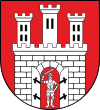 Alternate names: Błaszki [Pol], Blashka [Yid]. 51°40' N, 18°27' E, 44 miles W of Łódź, 17 miles ESE of Kalisz, in Sieradz County, Łódź Voivodeship, with 2,229 inhabitants in 2004. 1921 Jewish population: 2,186. A small Jewish community existed in the town in the mid-18th century. In the interwar period, there were nearly 5,000 inhabitants, half of them Jews. In December 1939 the Jews were resettled mainly in the Warsaw and Lublin ghettos founded in 1940; most of them were deported in 1942 and killed.
Alternate names: Błaszki [Pol], Blashka [Yid]. 51°40' N, 18°27' E, 44 miles W of Łódź, 17 miles ESE of Kalisz, in Sieradz County, Łódź Voivodeship, with 2,229 inhabitants in 2004. 1921 Jewish population: 2,186. A small Jewish community existed in the town in the mid-18th century. In the interwar period, there were nearly 5,000 inhabitants, half of them Jews. In December 1939 the Jews were resettled mainly in the Warsaw and Lublin ghettos founded in 1940; most of them were deported in 1942 and killed.
BLASZKI I: US Commission No. P0CE000680
Location: 51°39 18°26. 87 km. from Lodz. Cemetery: Sulwinskiego Street. Present town population is 1,000-5,000 with no Jews.
- Local: Urzad Miasta i Gminy, ulica Swierczewskiego 13, 98-235, Blaszki, tel. 29 24 91.
- Regional: Urzad Wojewodzki Konserwator Zabytkow, ulica Kosciuszki 3, 98-200 Sieradz, tel. 849-3815.
- Interested: Urzad Wojewodzki w. Sieradzu, Plac Wojewodzki 3, 98-200 Sieradz, tel. 849-71666. Zydowski Instytnt Historyczny w Polsce, ulica Tlomackie 315; 00-090 Warszawa; tel. 27-92-21.
The earliest known Jewish community is 18th century. In 1921, there were 2,261 Jews, (47.4%). The Orthodox and Conservative cemetery was established in 18th century. Other towns or villages used this cemetery but which is impossible to determine. The last known burial was the late 1939. The isolated urban flat land has no sign or marker. Reached by turning directly off a private road, access is open to all with no wall or fence or gate. No stones are left. It contains no known mass graves. The municipality owns the property is now used for agriculture. Adjacent property is agricultural and residential. Occasionally, local residents, private visitors, individual tours, and organized Jewish groups visit. It was vandalized during World War II but not in the last ten years. There is no maintenance or care. Within the limits of the cemetery are no structures. Security, weather erosion, and vegetation are very serious threats. Incompatiable existing nearby development is a moderate threat. Vegetation and planned development are moderate threats; pollution is only a slight threat.
Adam Penkalla, Gagarina 9/24, 26- 600 Radom completed survey in Nov. 1992 after visiting the site.
BLASZKI II: US Commission No. P0CE000681
Location: 30 Lecia PRL Street in Sieradz region. The cemetery was established in 18th century. Community was Orthodox and Conservative. Other towns or villages used this cemetery but which are impossible to determine. The last known burial was the late 1939. The isolated urban flat land has no sign or marker. Reached by turning directly off a private road, access is closed with a continuous wall and a locking gate. No stones are left. It contains no known mass graves. The municipality owns the property used for industrial purposes. Adjacent property is commercial/industrial. Occasionally, local residents, private visitors, individual tours, and organized Jewish groups visit. It was vandalized during World War II. There is no maintenance or care. Within the limits of the cemetery are no structures. No threats listed. The cemetery is now used for industry.
Adam Penkalla, Gagarina 9/24, 26- 600 Radom completed survey in Nov. 1992 after visiting the site.